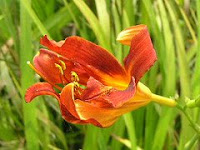 There is no doubt about it. No one brings a bareroot plant into the garden to display it as a focal point.
There is no doubt about it. No one brings a bareroot plant into the garden to display it as a focal point.
When we buy a bare root plant to add to our family we are buying into the future of what those ugly roots will produce for us. They remind me of a scraggly, unkempt plant that looks like it is about to transpire its last oxygen molecule. Some people just pass on any plant that looks like this relegating it to the compost pile. Others see them as an opportunity to test their nurturing skills, or simply as a mercy mission. Some see them as an opportunity to cheaply fill in that nagging empty space.
What type of plant person are you?
Bare-roots are ugly, but we buy them knowing they have so much potential at being beautiful, at being the star blossom that shines brightest in just the right spot, or at being a supporting player in your symphony of color and texture.
Seeds, with their various surface markings and colors are more beautiful than bare roots. And who can deny that nasturtium seeds have a lot of character.
Sunflower seeds come in solid black to grey and white stripes no two looking exactly identical.
Pumpkin and squash seeds can come in yellow, gold, white and mostly flat.
All seeds have their own character and distinguishing marks. They come in every color from black to white, rose to orange. All sizes, and shapes. Some even have wings, Maple for example. Some come in their own pods. Campanula itself comes in many different sizes, shapes and colors.
Bare root plants have a lot going for them over seeds. They already have roots and a collar, where the roots meet the growing stock, is clearly visible so you know exactly the correct depth to plant them, and they have a huge head start over seeds.
This is a particularly good time to shop for bare-root roses, fruit trees, and other nursery stock. Through mail order sources you will often find varieties that are not available locally, and planting bare-root plants in early spring is one of the most economical ways to add new plants to your garden. Plants will develop a strong root system that will adapt to our native soils.
Bare roots may be the ugly duckling of the garden world but in most cases they are an economical way to add a lot of beauty to your garden.
Read more...
 Then, of course there is signage that, in case you missed the point, just outright tells you what they think.
Then, of course there is signage that, in case you missed the point, just outright tells you what they think.





















